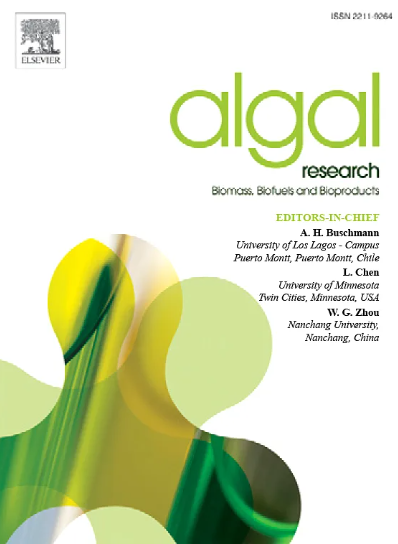通过气泡等离子激活空气保持新鲜螺旋藻(节藻)的质量和安全性
IF 4.6
2区 生物学
Q1 BIOTECHNOLOGY & APPLIED MICROBIOLOGY
Algal Research-Biomass Biofuels and Bioproducts
Pub Date : 2024-10-18
DOI:10.1016/j.algal.2024.103754
引用次数: 0
摘要
螺旋藻(Arthrospira platensis)是一种蓝绿藻,因其蛋白质、藻蓝蛋白和其他生物活性化合物而备受重视。然而,商业化室外栽培使其容易受到微生物污染,影响生物量的生产和质量。此外,大多数商业螺旋藻都以粉末、薄片和药片等干燥形式出售,这可能会降解这些生物活性成分。为了解决这些问题,冷等离子体等非热技术提供了一种很有前景的解决方案,它能有效减少微生物污染,同时保持产品质量,而无需干燥。本研究调查了用冷等离子体激活(BCPA)的气泡通过新鲜生长的螺旋藻来减少微生物污染和保持贮藏期间产品质量的潜力。在室外桨轮驱动池塘中生长的螺旋藻采收后呈糊状,重新悬浮在去离子水中,用等离子活化空气进行处理,并在 4 °C 下储存 28 天。与未经处理的对照组相比,这种处理方法大大减少了微生物污染,并保持了螺旋藻的生物量和色素含量。与对照组相比,处理后的样品细胞结构保持完整,颜色变化极小。此外,在整个储存期间,螺旋藻悬浮液的 pH 值变为酸性(pH = 4),与对照组相比,处理后样品的氧化还原电位显著升高(150 mV)。结果表明 BCPA 空气具有保持新鲜螺旋藻质量的潜力。这一发现可能会在螺旋藻行业有重要应用,为客户提供新鲜产品而不是干螺旋藻。本文章由计算机程序翻译,如有差异,请以英文原文为准。
Quality and safety of fresh Spirulina (Arthrospira platensis) maintained by bubbling plasma-activated air
Spirulina (Arthrospira platensis) is a blue-green alga valued for its protein, phycocyanin, and other bioactive compounds. However, its commercial outdoor cultivation makes it susceptible to microbial contamination, affecting both biomass productivity and quality. Additionally, most commercial Spirulina is sold in dried forms such as powder, flakes, and tablets, which can degrade these bioactive components. To address these issues, non-thermal techniques, such as cold plasma, offer a promising solution by effectively reducing microbial contamination while preserving product quality without the need for drying. This study investigated the potential of bubbling cold plasma-activated (BCPA) air through freshly grown Spirulina to reduce microbial contamination and maintain quality during storage. Spirulina grown in an outdoor paddle-wheel driven pond was harvested in paste form, resuspended in deionized water, treated with plasma-activated air and stored at 4 °C for 28 days. The treatment significantly reduced microbial contamination and maintained Spirulina biomass and pigment contents compared to untreated control. The cellular structure remained intact, and colour changes were minimal in the treated samples when compared to the controls. Moreover, the Spirulina suspension pH became acidic (pH = 4), and oxidation-reduction potential was significantly higher (>150 mV) in treated samples compared to controls throughout the storage period. The results demonstrate the potential for BCPA air to maintain the quality of fresh Spirulina. This finding may have significant applications in the Spirulina industry for offering customers fresh products rather than dried Spirulina.
求助全文
通过发布文献求助,成功后即可免费获取论文全文。
去求助
来源期刊

Algal Research-Biomass Biofuels and Bioproducts
BIOTECHNOLOGY & APPLIED MICROBIOLOGY-
CiteScore
9.40
自引率
7.80%
发文量
332
期刊介绍:
Algal Research is an international phycology journal covering all areas of emerging technologies in algae biology, biomass production, cultivation, harvesting, extraction, bioproducts, biorefinery, engineering, and econometrics. Algae is defined to include cyanobacteria, microalgae, and protists and symbionts of interest in biotechnology. The journal publishes original research and reviews for the following scope: algal biology, including but not exclusive to: phylogeny, biodiversity, molecular traits, metabolic regulation, and genetic engineering, algal cultivation, e.g. phototrophic systems, heterotrophic systems, and mixotrophic systems, algal harvesting and extraction systems, biotechnology to convert algal biomass and components into biofuels and bioproducts, e.g., nutraceuticals, pharmaceuticals, animal feed, plastics, etc. algal products and their economic assessment
 求助内容:
求助内容: 应助结果提醒方式:
应助结果提醒方式:


